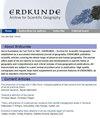The impact of Airbnb on a non-touristic city. A Case study of short-term rentals in Santa Cruz de Tenerife (Spain)
IF 1.1
4区 社会学
Q3 GEOGRAPHY
引用次数: 10
Abstract
Short-term rentals such as Airbnb have become a persistent element of today’s urbanism around the globe. The impacts are manifold and differ depending on the context. In cities with a traditionally smaller accommodation market, the impacts might be particularly strong, as Airbnb contributes to ongoing touristification processes. Despite that, small and medium-sized cities have not been in the centre of research so far. This paper focuses on Santa Cruz de Tenerife as a medium-sized Spanish city. Although embedded in the touristic region of the Canary Islands, Santa Cruz is not a tourist city per se but still relies on touristification strategies. This paper aims to expand the knowledge of Airbnb’s spatial patterns in this type of city. The use of data collected from web scraping and geographic information systems (GIS) demonstrates that Airbnb has opened up new tourism markets outside of the centrally established tourist accommodations. It also shows that the price gap between Airbnb and the housing rental market is broadest in neighbourhoods that had not experienced tourism before Airbnb entered the market. In the centre the highest prices and the smallest units are identified, but two peripheral quarters stand out. Anaga Mountains, a natural and rural space, has the highest numbers of Airbnb listings per capita. Suroeste, a suburban quarter, shows the highest growth rates on the rental market, which implies a linkage between Airbnb and suburbanization processes.Airbnb对非旅游城市的影响。西班牙圣克鲁斯德特内里费岛短期租赁案例研究
像Airbnb这样的短期租赁已经成为当今全球城市化的一个持久元素。其影响是多方面的,并因环境而异。在传统上住宿市场较小的城市,这种影响可能会特别强烈,因为Airbnb为正在进行的旅游进程做出了贡献。尽管如此,到目前为止,中小城市还没有成为研究的中心。本文以西班牙中等规模的城市圣克鲁斯为研究对象。虽然圣克鲁斯位于加那利群岛的旅游区,但它本身并不是一个旅游城市,但仍然依赖于旅游战略。本文旨在扩大对Airbnb在这类城市的空间格局的认识。使用从网络抓取和地理信息系统(GIS)收集的数据表明,Airbnb已经在中央建立的旅游住宿之外开辟了新的旅游市场。它还表明,在Airbnb进入市场之前没有经历过旅游业的社区,Airbnb和住房租赁市场之间的价格差距最大。在中心,最高的价格和最小的单位被确定,但两个外围区域脱颖而出。阿纳加山脉(Anaga Mountains)是一个自然的乡村空间,人均Airbnb房源数量最高。郊区的Suroeste在租赁市场上显示出最高的增长率,这意味着Airbnb与郊区化进程之间存在联系。
本文章由计算机程序翻译,如有差异,请以英文原文为准。
求助全文
约1分钟内获得全文
求助全文
来源期刊

Erdkunde
地学-自然地理
CiteScore
2.00
自引率
7.10%
发文量
17
审稿时长
>12 weeks
期刊介绍:
Since foundation by Carl Troll in 1947, ''ERDKUNDE – Archive for Scientific Geography'' has established as a successful international journal of geography. ERDKUNDE publishes scientific articles covering the whole range of physical and human geography. The journal offers state of the art reports on recent trends and developments in specific fields of geography and comprehensive and critical reviews of new geographical publications. All manuscripts are subject to a peer-review procedure prior to publication. High quality cartography and regular large sized supplements are prominent features of ERDKUNDE, as well as standard coloured figures.
 求助内容:
求助内容: 应助结果提醒方式:
应助结果提醒方式:


